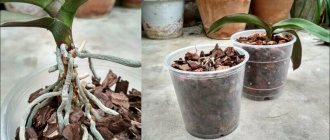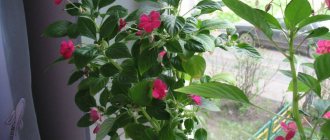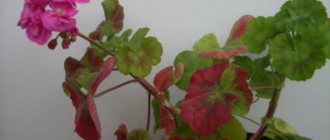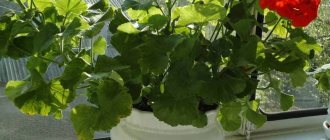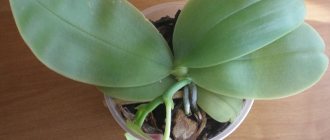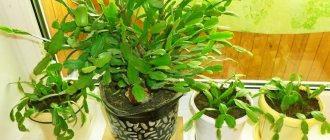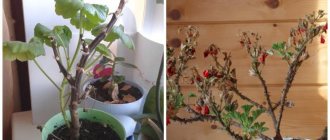In apartments and houses, bushes of exquisite flowering geraniums are often found on window sills. The plant is not considered rare, although some varieties are quite difficult to find. Pelargonium is easy to care for and does not require special conditions. Nevertheless, every gardener should know why geraniums do not grow in an apartment if the purchased bush was healthy and strong. It also happens that, having changed its habitat, it refuses to develop.
Why geraniums don’t grow: reasons
When planting a flowering plant on your windowsill, you should study its care preferences. Frequent reasons why geraniums do not grow are violations of agricultural practices.
Professionals reveal 4 secrets to successful cultivation:
- Regulated watering , which depends on the type of plant and the conditions under which it is kept. When watering pelargonium, you should remember that waterlogging the soil usually leads to the formation of rot. Most varieties prefer relatively dry soil. They are watered after the leaves droop slightly and show signs of wilting. In summer, the plant is watered every other day; in winter, the frequency is significantly reduced. Illiterate water procedures lead to the fact that the plant stops developing and stops growing. It is not recommended to spray geranium.
Growing on sunny windowsills (the optimal solution is placement on a south window) with direct sunlight. Light shading also suits her. But you shouldn’t place a flower pot away from windows. Shading causes the plant to shed its leaves, stop its development and freeze in the hope of becoming more active on sunny days.
- Temperature violation . If geranium grows poorly, what should you do - adjust the thermal regime for the plant? When growing crops, you should know that pelargonium prefers warmth in summer (22-26 degrees) and significant coolness in winter (12-16 degrees).
- Refusal to form a crown . It is advisable to prune pelargonium in the fall, in particular, after transplanting it into a pot. Many gardeners use pruning only if some branch gets out of the general mass. In fact, pruning will help to grow lush and low bushes with numerous young shoots.
If all the rules of agricultural technology are followed, but pelargonium still does not grow, you should:
Make sure that the size of the pot is suitable for the crop. You should not plant geraniums in large bowls, as this can lead to rotting of the roots. In addition, pelargonium will actively grow its root system, trying to entwine the earthen ball, and, naturally, will refuse to grow green mass. Too small a capacity is also an unfavorable factor. The optimal pot size is 15 cm in height and 14 cm in diameter.
Check if the soil is suitable for the plant. Very often, an excess of nitrogen leads to slow growth, although this component in a regulated amount promotes the development of shoots. In addition, soil acidity greater than 5.5 affects flower growth. Geranium prefers nutritious soil with an acidity of about 6.5 pH. Soil poor in nutrients will also cause slow development. Pelargonium is fed 2 times a month 4-5 times during the growing season.
Advice ! Geranium loves fresh air very much, but is afraid of drafts. In the summer, the plant is taken out into the garden or onto the balcony if possible. The pot is placed in a bright, quiet place.
Pelargoniums do not grow and bloom poorly
Pelargoniums do not grow and bloom poorly
Post by airin31 » 11 Oct 2022, 12:54
Pelargoniums do not grow and bloom poorly
I want to ask you about this. My pelargoniums lived on the balcony all summer, now I moved them into the apartment. “Not a fountain” condition. This is all that has grown over the summer, unfortunately. There is simply no growth, and flowering accordingly. Previously, I remember, we grew up without any problems and dancing with tambourines, but now the second year is some kind of strange story. They practically don't grow. A friend has the same situation. Take a look with a professional eye - what could be wrong? And what are my actions now? Trim them? Replant in new soil? I can’t even imagine what to cut there. One bun is only more or less... the rest are in a deplorable state
How to cure a plant
Pelargonium can be made to grow only by eliminating the factors that prevent it from developing. Help depends on the causes of the problem.
- If the plant has been standing in the dark and stretched out, it must be trimmed in the fall, moved to a cool room, and the amount of watering reduced. As soon as the sun pleases you with its spring warmth, place the pelargonium in the brightest place, increase watering, and feed it every 10-14 days.
If the reason that pelargonium does not grow on the windowsill is insects, the gardener needs to apply an insecticide. If an infection appears, spray it with fungicidal preparations.
It’s easy to determine the reason why geranium grows poorly and what to do to help the plant. The first thing a gardener needs to do is examine his beauty and analyze the care features.
Geranium (pelargonium) is valued for its lush and very spectacular flowering, lasting for several months. But if the rules of care or maintenance conditions at home are not followed, the bush will bloom very sparingly or inflorescences will not form on it at all. In this article I will try to name all the main reasons why indoor geraniums do not bloom.
Why doesn't geranium bloom at home?
The flowering period of geranium occurs in February-March and, provided proper conditions are created, can last until September. After the plant has finished flowering, it will begin a dormant period, during which it will gain strength in order to produce new healthy buds next spring. If during the prescribed period from February to September pelargonium does not produce flowers, then the gardener is faced with the problem of improper maintenance. But before taking any measures, it is necessary to establish why indoor geraniums do not bloom.
Wrong choice of pot
Lack of flowering due to an incorrectly selected container is usually typical for plants in the collection of novice gardeners. Many beginners do not know that pelargonium produces buds only when its roots fill the entire container of the pot. If your geranium is not blooming, pay attention to whether the container is too large. If yes, then it is advisable to transplant the flower into a tighter pot and provide it with proper conditions.
Heavy ground
Flower growers often plant geraniums in the soil of a vegetable garden or front garden during the summer holidays, and upon returning home they replant the geranium back into the container using garden soil. This cannot be done. The soil from the garden is too heavy, so the substrate in the pot should be replaced with a lighter and more fertile one. You can buy the soil mixture at a florist store or prepare it yourself by mixing sand, humus and garden soil in a 1:1:2 .
Important! It is not recommended to use garden soil that has not been disinfected. It may contain pests that can cause the death of the flower.
Improper watering
Do not forget that pelargonium is a drought-resistant flower, and therefore does not tolerate waterlogged soil. For geraniums, drought is more gentle than an overly moistened substrate. Excessive watering can lead to rotting of the root system of the flower, and moisture accumulated in the pan can cause the development of harmful bacteria. As a result, the plant will no longer receive the proper amount of nutrients, which will lead to deterioration in appearance and lack of flowering. Therefore, be sure to ensure that watering is moderate.
Incorrectly selected temperature mode
In order for geraniums to bloom in spring and summer, they require a period of temperature rest in winter. In an apartment during the heating season, the ideal place for wintering pelargonium will be the window sill, which is the coolest area in the heated room.
Fertilizer shortage
Some gardeners believe that properly organized watering is enough for geraniums to bloom. Actually this is not true. Pelargonium may not have enough nutrition in the form of water, so additional feeding of the plant with fertilizers, organized according to a certain scheme, will be required. If a flower does not have enough nutrients, it will simply not have enough “strength” to bloom.
Lack of lighting
Light-loving pelargonium will never bloom if there is not enough light for it. Also harmful to the flower are direct sunlight, which exhausts the flower.
No pruning or replanting
To make the flower comfortable, pruning and replanting will be required. In order for the flower to gain strength, it is not recommended to carry out the above activities in winter. Pelargonium cut or transplanted during the dormant period may not respond to the changes made in the best way and will not please you with the appearance of buds within the period established by nature.
Expert advice for lush flowering
To achieve abundant and regular flowering of geraniums, experts recommend:
- If the bush does not bloom, then it must be systematically rearranged in different places on different windowsills , which will help to find the place that best suits it. However, as soon as the buds form, turning and moving the bush is prohibited, otherwise they may fly around.
- As soon as the buds are formed, you need to pinch the tops of the shoots , thanks to this the bush will not build up green mass, which will have a beneficial effect on flowering.
- When growing several bushes at once in one container in the spring, be sure to replace the top layer of substrate, about 30 mm thick, with a new one.
Causes of delayed growth of geraniums - instructions for correcting the problem
In apartments and houses, bushes of exquisite flowering geraniums are often found on window sills. The plant is not considered rare, although some varieties are quite difficult to find. Pelargonium is easy to care for and does not require special conditions. Nevertheless, every gardener should know why geraniums do not grow in an apartment if the purchased bush was healthy and strong. It also happens that, having changed its habitat, it refuses to develop.
Shock therapy
“Shock therapy” is used only in extreme cases, when all the tips described above have not helped to achieve abundant flowering of geraniums. To do this, you should carry out severe pruning , during which you need to leave only 2 or 3 eyes on each of the branches.
Try replanting the flower in open ground
Also, if possible, the flower is transplanted into open ground. This is done in the last spring or first summer weeks. At the beginning of autumn, the bush is replanted in a container and brought into the house.
The presence of house plants has not surprised anyone for a long time, but their healthy appearance and constant flowering are not so often encountered. Flowers that are grown on the windowsill must perform certain functions assigned to them, and one of them is decorating the room through a combination of greenery and bright flowers. If you cannot achieve flowering, it is worth figuring out what the problem is. One of the most popular and desired house flowers is geranium, and it is a shame if it does not bloom for a long time.
Geranium stretched out in winter, what to do
It’s rare that someone doesn’t have pelargonium or, as everyone used to call it, geranium, blooming on their window.
She came to us from South Africa and is a representative of the Geranievs. It grows as a subshrub and as a herbaceous plant. The variety of flower colors is simply mesmerizing. Umbrellas, consisting of many flowers, humiliate the entire bush. The original fan-shaped leaves look very decorative. Pelargonium is a perennial plant. In summer you can decorate your garden with it. It tolerates transplanting into open ground and back into the room very well. But sometimes it turns out that geranium stretches out in winter and loses its shape, but today we’ll talk about what to do in this case, what mistakes were made when growing.
Features of flowering
Geranium plants that can be found in nature belong to the dicotyledonous family, which can be divided into 7 tribes:
- Geraniums;
- Pelargonium;
- Oxalis;
- Embalmed;
- Limnanthes;
- Vmanieae;
- Wendtii.
Geranium was first found in South Africa, and this territory is considered its homeland. Due to its attractive appearance, it was brought to Europe in the 16th century, and to Russia in the 18th century. The long flowering period is considered an advantage of this plant and maintains stable interest in it. You can see flowers from late spring to mid-autumn. Thanks to the fact that geranium began to be cultivated as a house plant, new varieties have appeared that have their own characteristics.
- Zonal has stripes on the petals that divide them into certain zones of different shades. This variant usually comes in white, red and pink colors. The peculiarity of the species is that the flowering period is short, but the process of new flowers appearing is so fast that it seems as if pelargonium never stops blooming.
- Fragrant differs from other varieties in the ability of the leaves to release aroma. It can be very diverse: mint, orange, apple, nut, and more. The plant itself grows small, has a compact crown and small foliage, and blooms with beautiful and bright flowers.
Features of growth and flowering
Geranium is unpretentious in care, since under natural conditions in the place where the flower grows, the climatic conditions are extremely harsh.
The flowering of geraniums also depends on a number of factors. Especially on how the flower spent the winter. In winter, the plant needs cool air and no heaters ; the temperature in the room where the geranium is located should be +12-13 degrees, not higher. At the same time, the plant does not require abundant watering and fertilizing.
If these conditions are provided, geranium will not get sick and will delight its owners with abundant flowering, which can last from spring to late autumn.
Another important condition for good flowering is the fact that the plant must be broken off withered inflorescences (what to do with faded geranium flowers?). These actions prolong the flowering period.
Geranium has long been successfully used in landscape design due to its attractive properties. Namely:
- Because of its bright, colorful and abundant flowering.
- The leaves of geranium are openwork, depending on the type they have different shades.
- Bushes of various heights, from 10 cm to 1 meter, due to this you can create various compositions in a flowerbed or garden plot.
Causes
If there are indoor flowers in the room and their development is proceeding correctly, then the care and conditions are completely suitable for them. When geranium does not bloom, it is worth understanding the reason for this in order to quickly remove it and give the plant the opportunity to fully grow and please the eye. Let's look at a few of the most common reasons.
- Lack of necessary fertilizer. Geranium prefers potassium supplements and does not need organic ones, therefore, when choosing fertilizers, you should be careful.
- Failure to comply with watering conditions. It is important to properly add moisture to the pot; if there is too much moisture, the plant will deteriorate very quickly. It is easier for a flower to have no water at all than to have too much of it.
- Wrong selection of pot. If you choose too large a container for geranium, then the presence of a significant earthen lump will force the root system to actively grow, and the bush will begin to stretch upward, completely forgetting about flowering. If it is not possible to purchase a suitable pot, then you can place several bushes in one container so that they help each other.
- No trimming. If pruning is not done in time, the geranium may not bloom. The flower grows actively, and if it becomes dense, it produces only foliage, completely stopping flowering. The optimal timing is considered to be spring or autumn.
- Lack of light. Pelargonium is a light-loving flower, and if it does not receive the proper amount of light, it actively reaches up to get an extra ray of sun or lamp light.
- Unsuitable conditions in winter. It is important to reduce the air temperature to 16 degrees, avoid drafts, water with a small amount of water and light the plant for at least 5 hours a day.
If geranium grows normally, but you cannot wait until it blooms, then you should pay attention to other factors.
- The soil . The soil for geraniums should be loose and fluffy; if the soil is clayey, the plant will not bloom. The most suitable soil for pelargonium will be the ratio of garden soil, sand and humus in the proportions 2: 1: 1. The problem may lie not only in the composition of the soil, but also in its density. If you do not replant the flower for a long time, the soil will be compressed and will be unsuitable for the normal development of the plant. At least once a year you need to replant or update the top layer of soil.
- Diseases . If the flower is healthy, then checking all the described factors will help identify the reason for the lack of flowering. If we are talking about a disease, then you need to pay attention to the appearance of the geranium. If its leaves change color, spots, mold or white coating, ulcers, abrasions appear on them, then there are clear signs of the disease. To properly fight a disease, you need to understand its nature; it can be bacterial, viral, fungal. Timely treatment will help save the flower and ensure its normal growth and flowering.
Knowing all the main causes of problems with the flowering process, you can quickly identify the problem and solve it, achieving a positive result, and no longer encounter similar situations in the future.
Geranium blooms, but the leaves do not grow - why does this happen and how to avoid it?
Geranium is considered one of the most famous indoor plants. There are many varieties and species of this plant. Caring for geraniums is not difficult.
But it happens that flowering is observed, but there are few leaves on the flower. The answer may be hidden even in the most unexpected places.
What is the reason for this and how to eliminate this error? More details will be described in the article below.
Troubleshooting
If caring for geraniums is correct, but it is not possible to achieve flowering, then you can try radical measures to combat the problem. One of the options is shock therapy, in which unfavorable conditions are created for the flower that threaten the integrity and health of the plant. The point is to force the biological mechanism of procreation to turn on, so that the bush throws out color to produce seeds in the event of the death of the main plant.
To carry out such stimulation, several methods can be used:
- early and severe pruning of the bush, when no more than two eyes remain on it;
- creating cold environmental conditions in winter and lack of proper watering;
- transplanting into the ground or onto the balcony ahead of schedule;
- increasing iodine content.
In order for the bush to bloom steadily and for a long time, you need to know some of the features of geranium.
She does not like to be moved and moved to a new place, especially when this happens during flowering. Pelargonium can react very sharply, completely losing color with minimal movement.
In order for the bush to grow normally and color, you need to do everything necessary for this.
- Organize proper watering , moisture is added only when the top layer of soil has dried well. If the flower is in the garden, then its watering depends on the weather outside. In cloudy and rainy weather, you should not water the bush more than 2 times a week. To make sure that watering is carried out on time, you can look at the foliage of the geranium. If overwatered, it will begin to wither and curl, after which plaque and rot may appear on it. It is important to adjust the added moisture in time, otherwise the bush will not be saved.
- Adjust temperature readings. If the room is less than 15 degrees, the bush will begin to “fall asleep,” which is quite normal for the winter period, when pelargonium can rest and gather strength, and by spring it can begin to grow and bloom well. In the warm season, lighting mode becomes more important.
- Provide light. To form buds, the flower needs the sun, so indoors the pot should be placed on a south window, and in the garden bed the bush should be planted in a well-lit area, but shaded during the lunchtime heat. If the trunk begins to shed its leaves, it means that the flower does not have enough light.
- Choose the right size of the pot - it must match the size of the flower, as well as high-quality, light and nutritious soil.
- Do not spray geraniums. The home flower does not need to be sprayed, as it does not like it. Simple watering is enough for normal growth of the bush. Garden geranium also prefers to do without additional shower procedures.
Why is this happening
If a geranium blooms well, but leaves do not grow on it, then there is a reason for this, therefore, it is necessary to understand why this is happening and eliminate the problem. Geranium leaves may fall off and expose the stem as a result of the following reasons :
Due to drying out.- Due to fungal infection (most often as a result of Botrytis activity).
- As a result of rust damage.
- Due to disease - spotting.
- Due to swelling.
The leaves dry out from lack of moisture and lighting . Yellowing or whitening occurs due to too warm an environment or infrequent watering.
If the leaves turn yellow after the geranium has been transplanted, then there is no need to worry too much; in most cases, everything returns to normal over time.
The fungus attacks geraniums due to too frequent watering. Rust appears on geraniums due to the same fungal infection. Spotting occurs against the background of excessive humidity in the room and elevated air temperatures.
Swelling may occur when:
- Excessive watering.
- Reduced air temperature.
- Cold soil.
